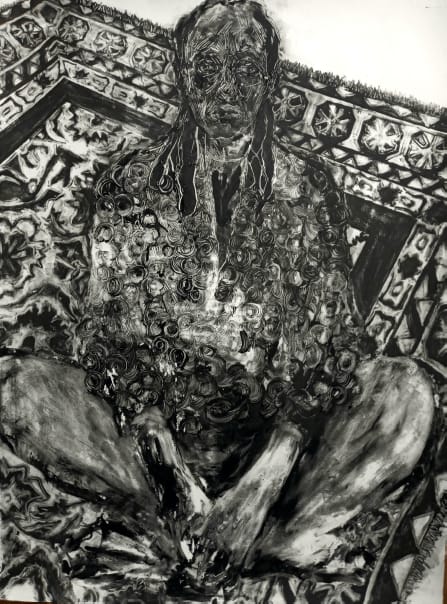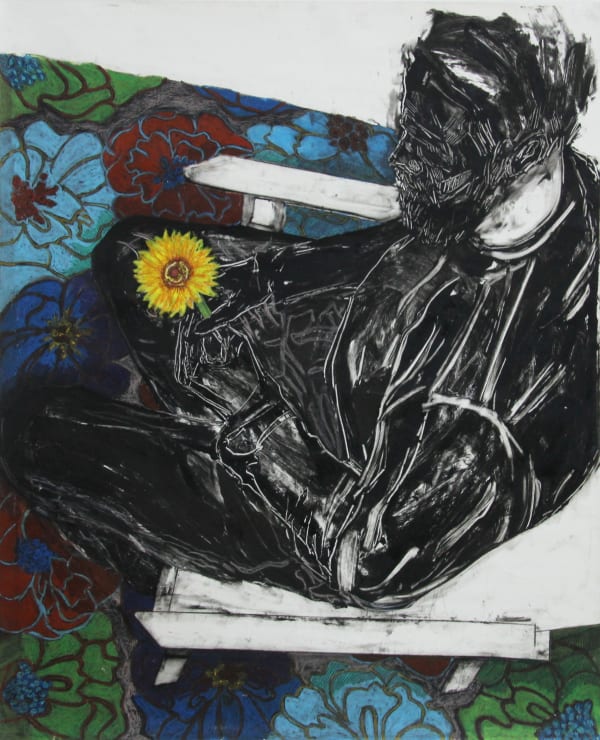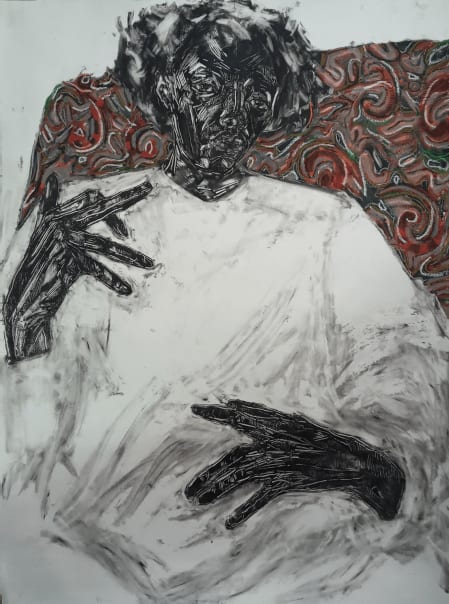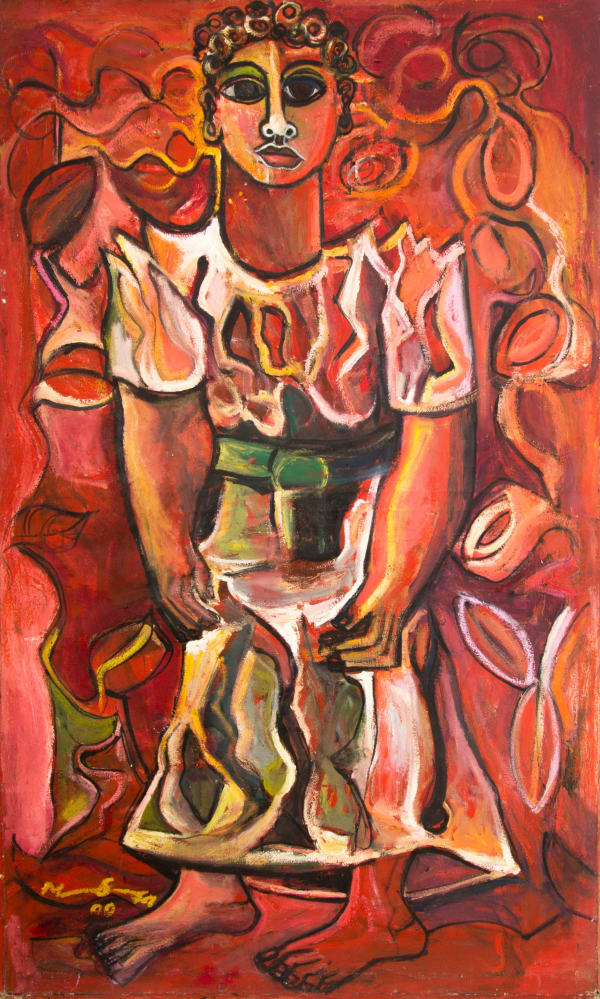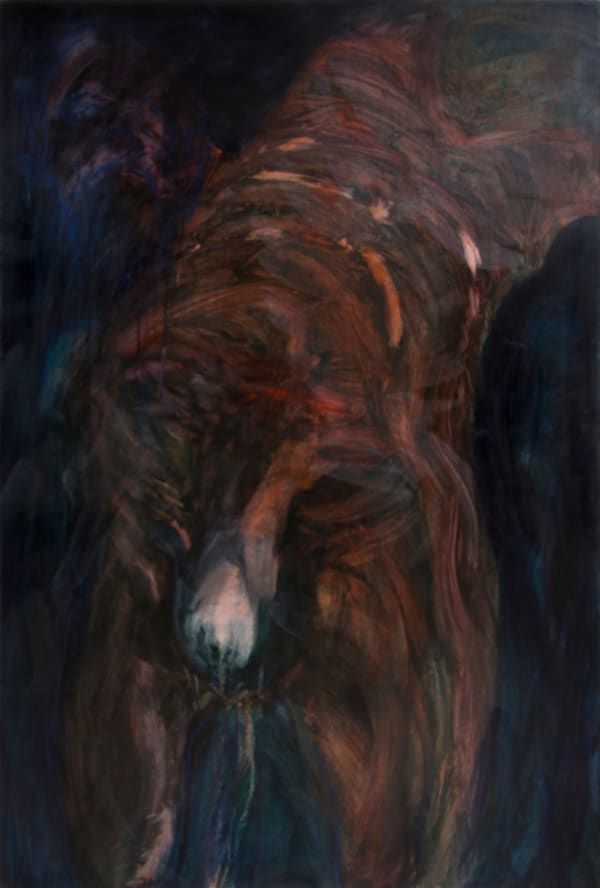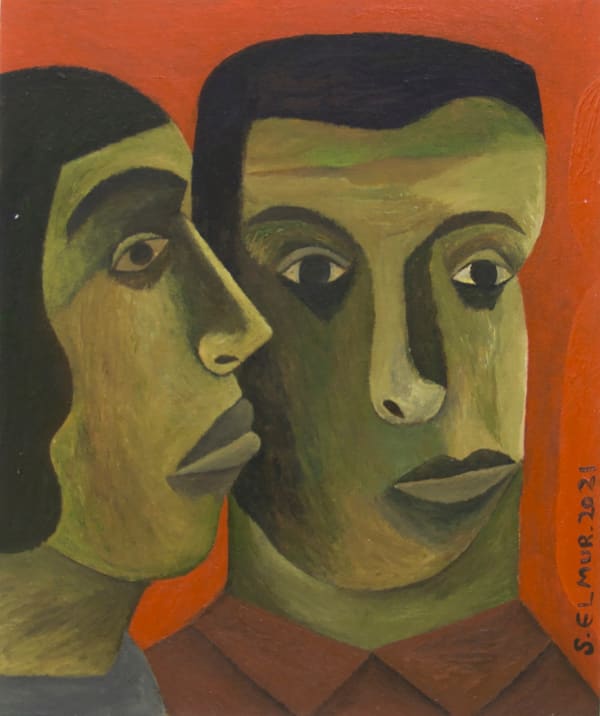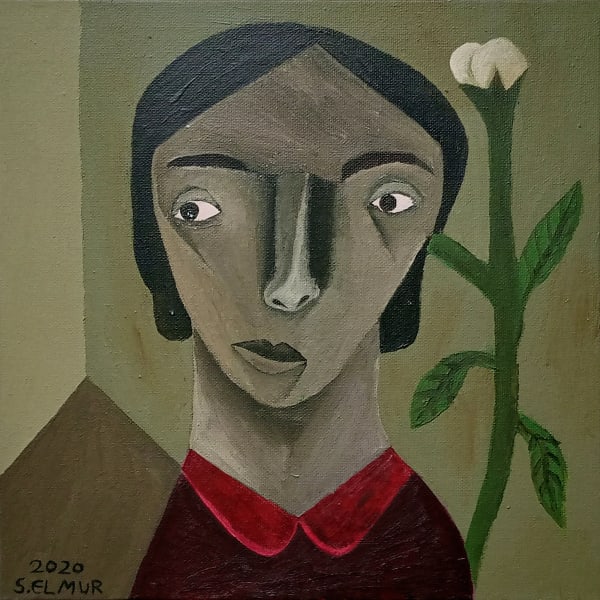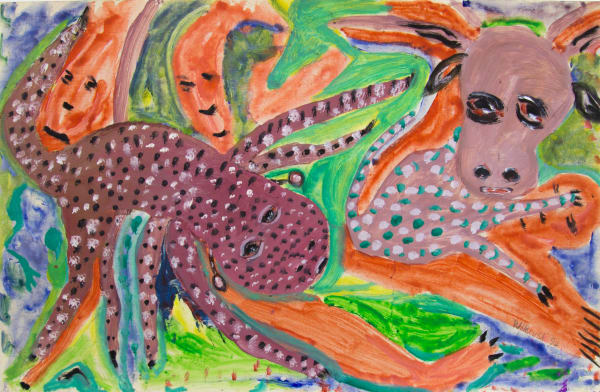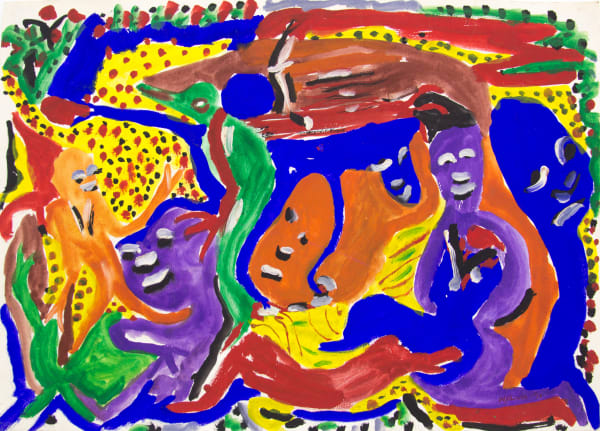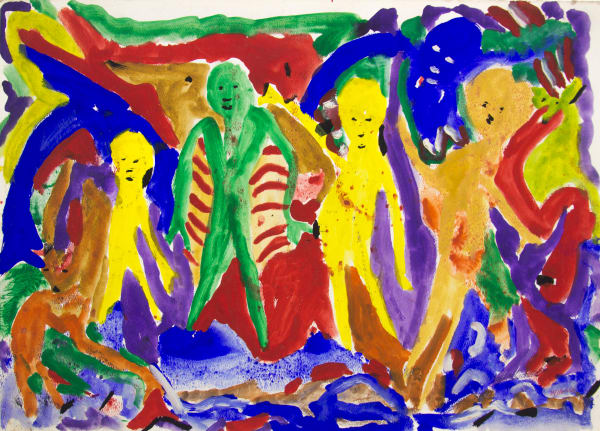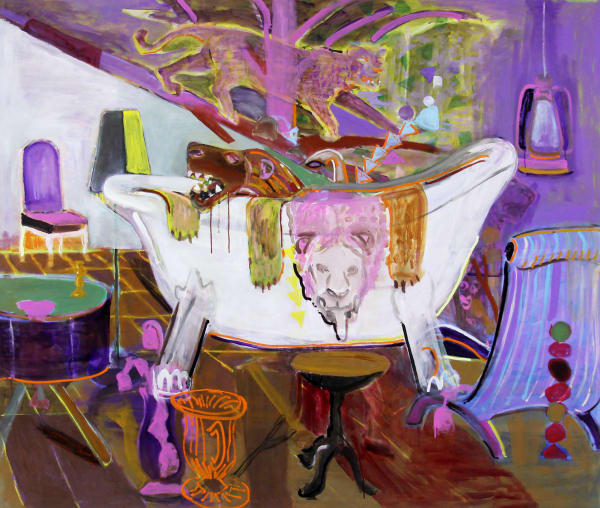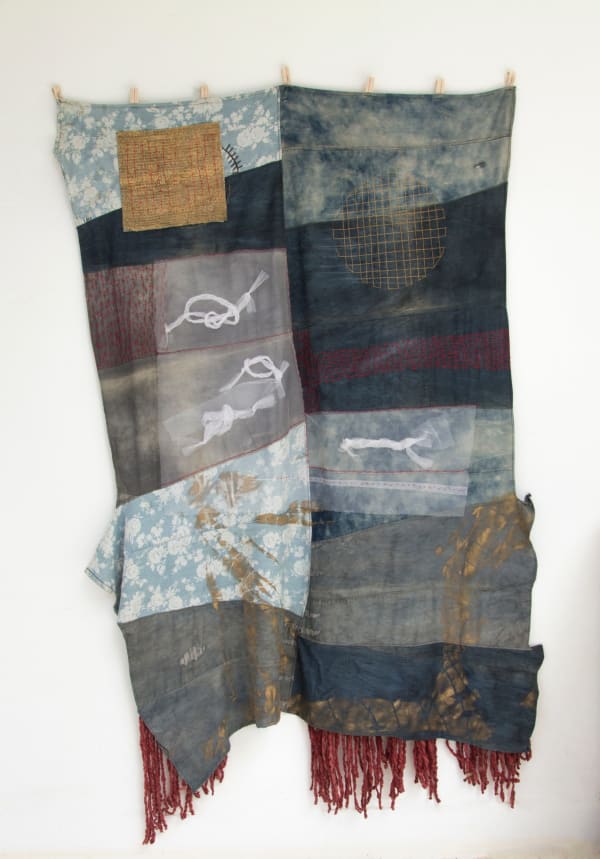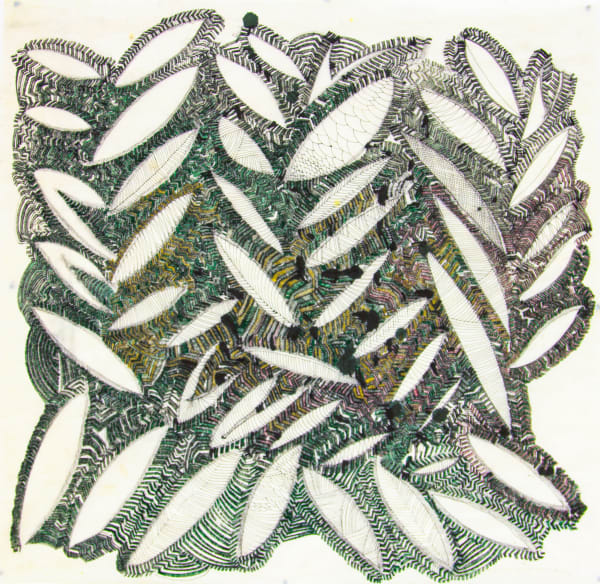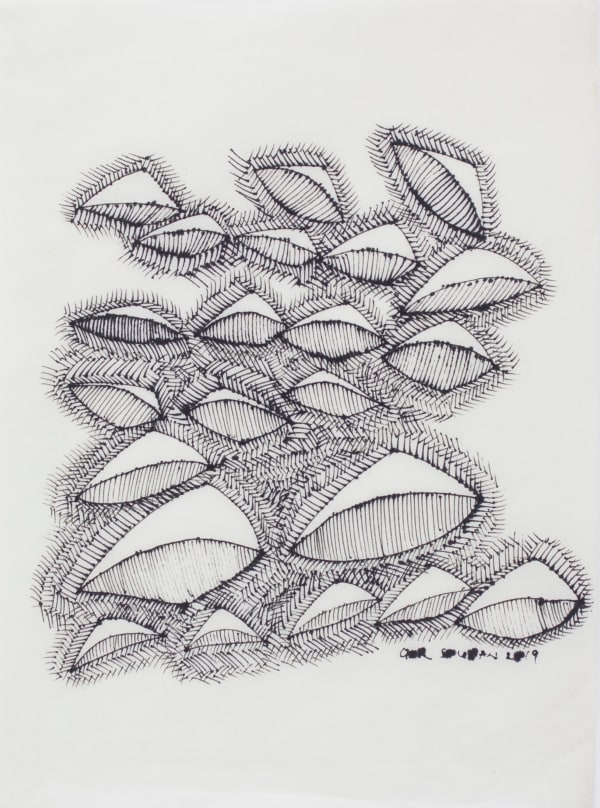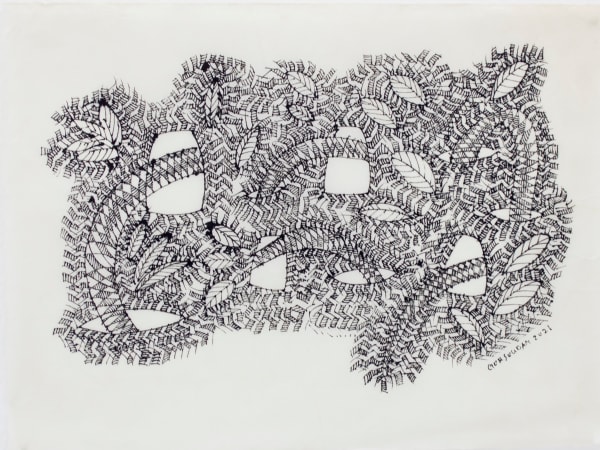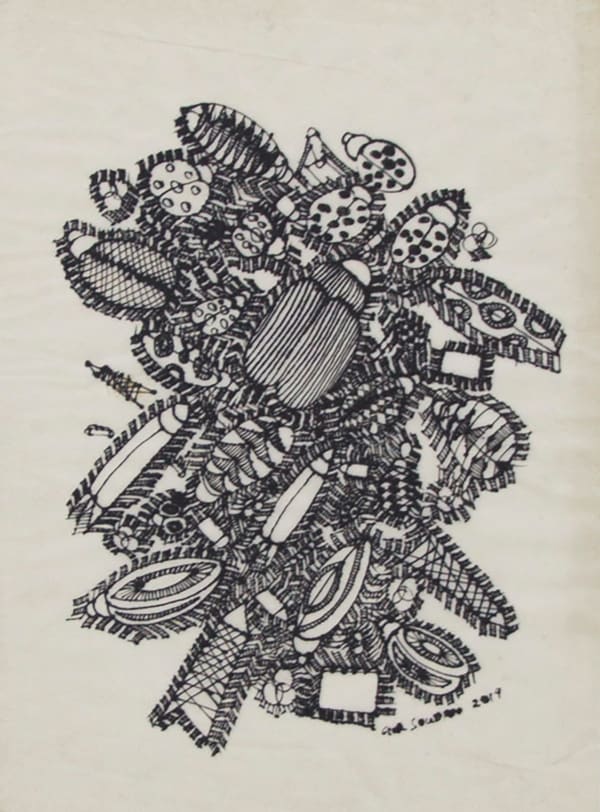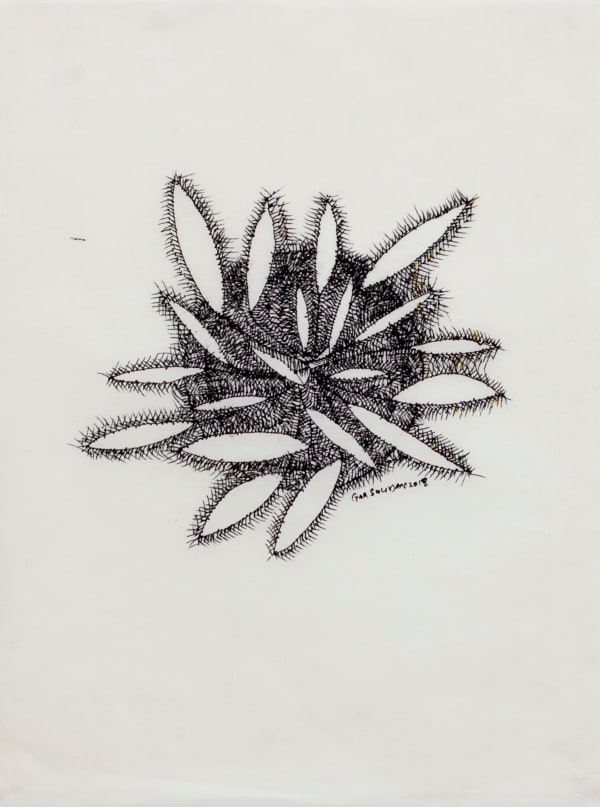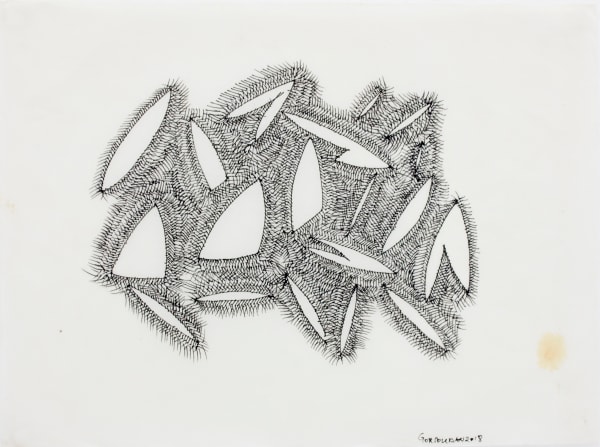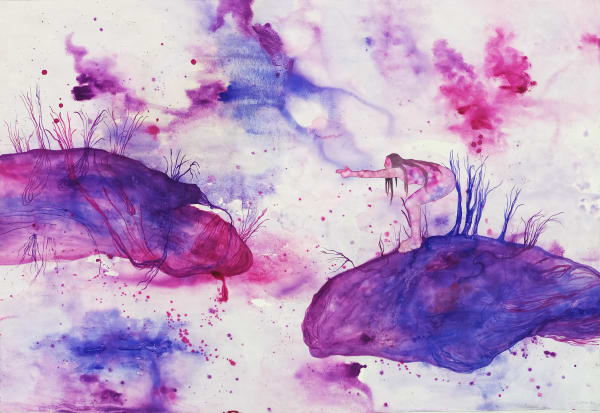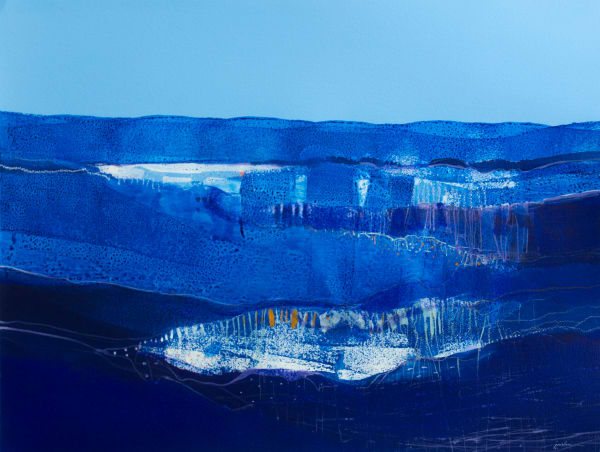Fictions: Group Exhibition: Circle Art Gallery
FICTIONS
11 May - 11 June 2022
Featuring: Gor Soudan, Jonathan Fraser, Maliza Kiasuwa, Tiemar Tegene, Beatrice Wanjiku, Geoffrey Mukasa, Sujay Shah, Nahom Teklehiamanot, Wanyu Brush, Salah Elmur, Tahir Karmali
Circle Art Gallery is pleased to present Fictions, a group exhibition of 11 artists at various stages of their careers, working in painting, drawing, printmaking. This grouping of artists/artworks invites the viewer to consider possible relationships between one work and the next and, by extension, between each artist’s practice and the next. The title of the exhibition Fictions speaks to the possible connections that can emerge in the distance between artworks; and how that space can offer room for the viewer to begin thinking about thematic connections and overlaps. Fictions contends that one artwork/artist can expand the viewers thinking about another
How, for example, do the intricate drawings of Gor Soudan, which intermingle the natural and man-made in our environment relate to the large abstract, iterative, landscape-inspired works of Tahir Karmali, or the material experiments of Maliza Kiasuwa? Where does the interiority that marks the works of Beatrice Wanjiku and Tiemar Tegene meet the narrative, observational quality of Salah Elmur and Geoffrey Mukasa’s portraits? Can the unfixed compositions of Jonathan Fraser somehow lead one to the dreamlike visions of Wanyu Brush? How do inanimate objects take on new lives in the paintings of Sujay Shah and Nahom Teklehaimanot?
Such questions - perhaps they are suggestions - lie at the heart of the exhibition. The show treats visual, thematic, and material parallels and starting points for richer, more involved interpretations of the selected works. The exhibition insists that we think of artworks as existing within a broader context of making and thinking, and not solely as discrete objects emerging from the studio.
Tiemar Tegene (Ethiopian, b. 1985)
Tiemar Tegene’s works are anchored in her training as a printmaker, expanding etching processes into practices of monoprinting through spontaneous experiments, most often using found household items and their textures. Although falling into this category, she doesn’t implement numbered editions struck from the same plate. Rather, each unique work falls outside of fixed description as she finds new ways to press the texture of an image through the application of ink onto the page. Many of these registers are then followed by additions of coloured pencil, forging repeating icons and patterns that become more abstracted and at the same time add further layers to the personal narratives relating to each subject. As these elements come together she presses at the boundaries that exist within and between human beings—those that exist naturally within each person as well as those that are constructed by oneself.
Tegene’s compositions are transmutations of her own emotional experience and the nature of her relationships with others, channelling a highly personal response to the world around her. Inside these images live the details and echoes of larger stories, whether relayed in confidence by a close friend, via an overheard phone conversation in public, or from a heated exchange between a couple on the street, and even drawn from song lyrics or fictional film narratives. Ultimately, her portraiture reaches for that specific, consuming emotional moment that ripples through the body and (therefore) through space, too. Each unique print speaks to this particular mode of relation, consolidating “real” details with flourishes of reference and imagination, or fragments from her own face used as part of another’s. Through this process, she steps out of an emotional space and into an expressive one. Intensities of colour or black and white deliver the “unexplainable strength and vibrant power” that tie the two together. Tegene seeks to explore self perception, subjective experience and daily life; to look at memory and history, resistance, dreams and visions, the body and individuality; to depict both wishful thinking and fear, isolation and lust for life; curiosity, depression, pride and confusion. Ultimately, the portraits reflect the complex world of feeling and experience of us.
Tegene received a BFA in printmaking from the Allé School of Fine Arts & Design, Addis Ababa. she is currently living and working as a full time studio artist in Addis Ababa Ethiopia Her work has been exhibited at the National museum of Ethiopia, Alliance Ethio-Francaise, Modern Art Museum Gebre Kristos Desta Centre, and the Lithuanian National Museum of Art, Circle Art gallery Nairobi Kenya, James Fuentes Gallery New York, well as a series of public murals commissioned in the city of Addis Ababa.
Geoffrey Mukasa (Ugandan, 1954 - 2009)
Geoffrey Mukasa is widely recognized as one of East Africa’s most influential painters. Born in 1954 to a medical doctor and the daughter of a Chief, Mukasa spent part of his childhood in the King’s palace in Buganda. Following the coup of Idi Amin, Mukasa left Uganda to study fine art at the Lucknow College of Art and Crafts in India. This period for Mukasa was one of much formal experimentation shaped by his research into both Indian and European art movements. When Mukasa returned to Uganda he had developed a distinctive style of painting, frequently focusing on relationships and interactions between humans and with their environment.
During the early 1990s Mukasa became a key figure in the movement to revive cultural life in Kampala. This movement was seen as a unifying force and an inspiration for the nation’s recovery after years of military dictatorship.
In his early years as an artist, Mukasa had largely worked in collage because of the difficulty in accessing classic art materials in Kampala at the time. It was only later, and to great success, that he began to paint on canvas.
The depth of influence of Indian art on Mukasa was reiterated by his inclusion in an exhibition of Indian Modern Art at Villa Vassilieff Gallery, Paris, 2017. In 2016, Mukasa’s work was shown in a solo presentation at Art Dubai Modern. His work is held in collections in America, Europe and Africa, and appears frequently at international auctions, including Sotheby’s and Bonhams.
Publications include Mukasa Geoffrey – the Artist’s Life in Uganda, AKA Gallery Kampala published by Maria Fischer, Rose Kirumira, Paul Lubowa and Josephine Mukasa, 2011.
Beatrice Wanjiku (Kenyan, b. 1978)
Beatrice Wanjiku’s distinctive canvases and works on paper probe the human condition, delving into the psyche to question notions of reality and positionality. Taking her own experiences as a jumping off point for her investigations into existentialism, Wanjiku’s practice scratches away at the superficial images we project into daily life, peeling away the layers that constitute social norms to reveal spectral figures, Wanjiku believes represent our inner selves.
Her wraith-like figures float away from their monochrome habitats, sometimes alone, sometimes clustered in groups, their form bleeding into further abstraction. A recent body of her work comprising paintings and collages, takes the motif of the straitjacket as an entry point into a wider exploration of social boundaries and regimes of thought.
Some selected exhibitions include "Catch a Fire," New York (2021), "Mourning a Memory," Nairobi (2018), Personal Structures “Open Borders” 57th Venice Biennale, Italy (2017), VOLTA New York (2017), “When The Heaven Meets The Earth,” Cambridge Londmon, (2017), 1:54 New York (2016), The OSTRALE 2015, Dresden, Germany (2015) and Guess Who’s Coming to Dinner, Richard Taittinger Gallery, New York, USA (2015) curated by Ugochukwu Smooth Nzewi.
She is a recipient of the UNESCO Aschberg Bursary (2013); Lava Thomas and Peter Danzig Fellowship Award (2013); Robert Sterling Clarke Foundation Fellowship (2011); and Alliance Francaise and Goethe-Institut’s Most Promising Female Artist Award (2006).
Her recent international artists’ residencies include Art Omi Residency, New York, USA (2018), the Iwalewa Haus Artist Residency Program, Bayreuth, Germany (2015), Djerassi Resident Artist Program, Woodside, CA (2013), and Vermont Studio Centre Program, Johnson, VT (2011).
Salah Elmur (Sudanese, b. 1966)
Elmur’s work is composed of a fertile visual vocabulary that draws on his social and cultural heritage. He draws on his observations of life and memories of his childhood and youth for the scenes, situations and impressions that he depicts in his work. Heavy symbolism, a tendency towards vivid colour combinations, and distortion of natural figures and proportions are some of the markers of Elmur’s painting.
Inspired by the many photographs he has collected from his family’s photography studio, Elmur’s paintings often emulate formal portrait settings with additional elements that complement but also unsettle the mood in his paintings. Plants and animals share the frame with the human subjects, limbs are shortened and proportions are distorted, altering the relationships between various objects and figures in the frame. All these elements are combined in a somewhat surrealistic swirl of memory, and the resulting paintings are tender, intimate vignettes of human relationships, the rituals and poetry of daily life and folklore.
Salah Elmur originally studied Graphic Design at the College of Fine and Applied Art, Sudan University, Khartoum. With a career spanning three decades, he has spent years travelling and living across East Africa and the Middle East and has participated in group and solo exhibitions in East Africa, the Middle East, Europe and America since 1985. Elmur has also published 12 children’s books and is a successful filmmaker; directing six short documentaries and fantasy films, which have been shown at international film festivals. In February 2018, the Sharjah Art Museum in the UAE held Fragrances of the Forest and Photos, a retrospective of Elmur’s work, followed by Forests and Spirits, an exhibition at the Saatchi Gallery in London alongside two luminaries of Sudanese modernism, Kamala Ishaaq, and Ibrahim El Salahi. He participated in a group exhibition at the British National Museum and his work is collected widely and is included in the permanent collection of the Museum of African Contemporary Art Al Maaden (MACAAL) in Marrakech, the Sharjah Art Foundation (SAF), Zeitz MOCAA, Minneapolis Institute of Art, Weisman Art Museum and the Pompidou Centre, Paris.
Jonathan Gathaara Sölanke Fraser (Kenyan b. 1995)
Fraser uses drawing as a means to engage with the world around him through a varied approach that includes observational sketching, plant pressing, digital image collection, and writing. This multifarious set of activities presents a unique opportunity to activate his interaction with his environment. This interactivity with the world strives towards a more internal and intuitive “knowing”; a knowing born less of experience and learning and more of dreaming. Fraser works through drawing to complicate meaning as well as create new relationships between objects and ideas. Disparate elements in the drawing field are allowed to take up similar qualities in space, eschewing the various contexts they would typically exist in. The drawing field itself is broken down so that one’s conventional approach to looking at and understanding it is revised. The drawings are energetic and enigmatic and in this way encourage the viewer to participate actively in the processes the artist himself uses.
Fraser invites the viewer to consider the transformation, big or small, that is brought by even the slightest shift in the conditions under which we encounter, or are presented with an object. This process of de-contextualization - sometimes subtle, other times abrupt - is aided by the repetition of certain motifs and objects within and across several compositions, a gesture that extends them across space and time. This reiteration and multiplication stretch the distance between the initial and final encounter with an object within the work. In doing so, it engenders a slowing down and increased attentiveness to these groups of interactive symbols and how they function according to the illogic of Fraser’s environments. In these works, the artist emphasises the contingent nature of meaning, highlighting how our reading of objects is dependent on their relationships with other objects, with space, and with time.
Fraser studied Fine Art at Kenyatta University. Previous exhibitions include I Will See What I Want To See, 2019 at Circle Art Gallery; If Not Now, 2018 at Cave Bureau, Nairobi; Line: The Basic Element, 2018 at One Off Contemporary Art Gallery, Nairobi; Stranger Times, 2017 at Circle Art Gallery; Anatomy of Me, 2017 at The Art Space, Nairobi. His most recent exhibition is 'There's a Time and a Place, a solo exhibition at Circle Art Gallery in May 2021.
Wanyu Brush (Kenyan, b. 1947)
Wanyu Brush is one of the founding fathers of modern East African art, co-founding the Ngecha Art Group with fellow artists such as Sane Wadu. Part of Ruth Shaffner’s stable of artists at Gallery Watatu, he was widely exhibited and collected in the 1980s and 1990s both locally and internationally. Best known for his vibrant configurations of human and animal forms, Brush is still active, working from his home in Ngecha, where he continues to produce vivid canvases depicting scenes of human chaos.
Sujay Shah (Kenyan, b. 1991)
Sujay Shah uses the language of painting and drawing to satirise colonial pasts whilst also exploring absurdity in the present and futures. Shah creates absurdist tableaus and dioramas; precarious congregations of objects, animals, and human beings which speak to a history of colonial plunder and the perverse human need to exert dominion over the natural world.The work draws on the legacy of early human interest in classification and taxonomy. The interiors of colonial-era homesteads, safari lodge decor and museum dioramas become reference points for the tendency to marvel at and exoticize places and objects that are foreign. Shah relies heavily on the imagery and theatre of practices such as taxidermy, and the hoarding of cultural artefacts and biological specimens, gathering objects into interiors forever weighed down by their past. Anthropomorphised animals and objects, colour and pattern are all deployed in ways that suggest levity, a counterpoint to an underlying existential dread. It is from this perspective that Shah explores the complexity of the relationships of the human species amongst one another and with the natural world.
Based in Nairobi, Shah received a BFA in Painting from the Savannah College of Art and Design in 2013 and went on to live and work in New York, working as a studio assistant for the artists Paul Bloodgood and Anne Chu.In Kenya his work has been included in group exhibitions including If Not Now (Cave Bureau, 2018), I Will See What I Want To See (Circle Art Gallery, 2019) and Various Small Fires (Circle Art Agency, 2021). His work has also been exhibited in the US (Savannah, Georgia and New York) and France (Lacoste).
Tahir Karmali (Kenyan, b. 1987)
Tahir Karmali is primarily an investigator of materials and their underlying source – as currency, as markers of cultural identity, or as exploitable artefact. He is invested in transforming these materials into varying formats (sculptural installations, drawings, print-based works, textile works) that are deceptively beautiful or attractive, as art object while also allowing the viewer to savour them as primary material before a layers of of transformation resulting from movement, migration, and displacement unfold. His work is based on his own physical experience of moving between borders, and globally diverse cultures, as well as the movement of certain elemental materials through these same routes and how they are thus transformed depending on their use value in each space, including within the art world.
Tahir Karmali received a Masters in Digital Photography from the School of Visual Arts in NY in 2015. He has participated in numerous workshops and exhibited widely, including: Tracing Obsolescence, Apexart, New York, 2018; Immigrant Artists and the American West, Tacoma Art Museum, Washington, 2018; New Threads, Circle Art Gallery, Nairobi, 2018; Biennal Forografica Bogota, 2017, Bogota, Columbia and PAPER:work, Pioneer Works, New York, 2017. Karmali’s work has featured in the Addis Foto Fest, Lagos Photo Festival. In 2019, he was one of the artists commissioned to create work following the inaugural Open Call for The Shed Museum in New York. Karmali’s practice focuses on the transformation of objects and materials by global economic flows. He draws on his observations of these, as well as his own physical experience of moving through international borders and cultural spheres. Forthcoming presentations of Tahir Karmali’s work include a solo exhibition at Circle Art Gallery, Nairobi, in September 2022, as well as presentations at the Armory fair in NY and 154 Contemporary African Art Fair in London.
Maliza Kiasuwa (Congolese, b. 1975)
Maliza Kiasuwa’s constructions are deeply rooted in the cultural, social, and political context of Kenya, but more generally of Africa and the world. Combining handmade materials from Japan with found objects from around her farm on Lake Naivasha, in the heart of Kenya’s Great Rift Valley, Kiasuwa embraces her chosen material’s earlier character and vocabulary, but transfigures their context by sewing, stitching and mending to produce unexpected narratives and representations of society, events, and global issues. As a visual artist of European and African descent, Kiasuwa brings a panoptic perspective to her border-crossing work, which regards the coexistence of two worlds as an endless source of inspiration, and a potential space for reconciliation.
“My sculptures and collages are made of bits and pieces that I collect during my daily expeditions: cotton threads, handmade ropes made of straw or rubber, plastic bags stranded on the lake shore,” said visual artist Maliza Kiasuwa. “These materials are representative of culture and history in the context of the global flow of goods, especially in terms of how their utility values shift over time. Sometimes I combine local materials with handmade fabrics such as Japanese Washi paper. I like to blend materials which don’t belong together.”
Gor Soudan (Kenyan, b. 1983)
Gor Soudan’s art practice shifts fluidly from the conceptual and philosophical to the physical and sensual. Mind and body are engaged in an exploration – through material labour – of the interactions observed by the artist in the surrounding environment. Simultaneously referencing both body and landscape, Soudan’s work reflects on how histories of human agency are written on both. Soudan has held numerous solo exhibitions in Kenya, including Imprints, Redhill Gallery, 2017 and Join the Dots, Circle Art Gallery, 2015. He is a Backers Fellow, after taking part in the Arts Initiative Tokyo residency in Japan in 2014. As well as Tokyo, Soudan has also exhibited in Freetown, London, Dubai and New York. His work is well collected, represented at Iwalewa-Haus, Bayreuth, as well as many private collections internationally.

